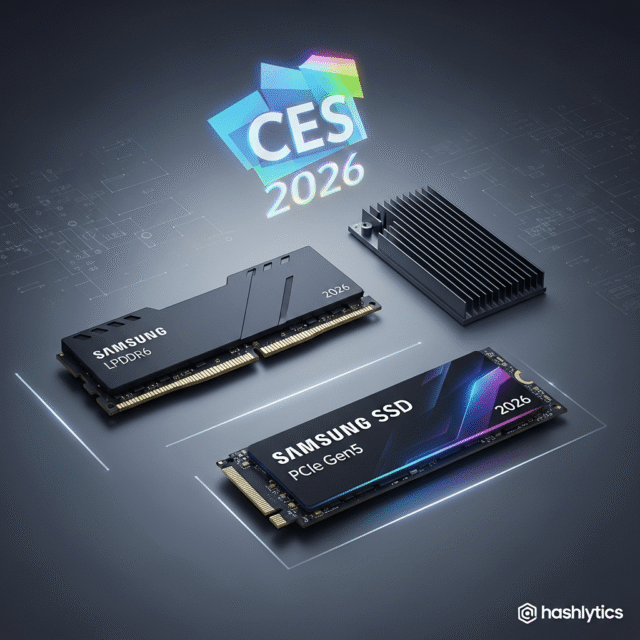Imagine a world where your smartphone effortlessly handles complex AI tasks, resource-intensive games, and massive datasets without breaking a sweat. Samsung’s LPDDR6 RAM is designed to make that a reality. Built on a cutting-edge 12nm process, this memory module boasts speeds reaching a staggering 10.7 Gbps. This represents a significant advancement in low-power double data rate (LPDDR) technology, which is crucial for mobile devices and other power-sensitive applications.
That’s an 11% jump over the already impressive LPDDR5X. To put this into perspective, LPDDR5X itself offered substantial improvements over its predecessor, LPDDR5, enabling faster application loading times, smoother multitasking, and enhanced performance in demanding applications like augmented reality (AR) and virtual reality (VR). The move to LPDDR6 further amplifies these benefits. But speed isn’t everything. Samsung is also prioritizing efficiency, claiming a 21% improvement in power consumption through a dynamic power management system. This means longer battery life, even under heavy workloads. This dynamic power management system intelligently adjusts the power consumption of the RAM based on the current workload, minimizing energy waste when the device is idle or performing less demanding tasks. This is particularly crucial for extending the battery life of smartphones, tablets, and laptops, where power efficiency is paramount.
The increase in Input/Output (I/O) count further enhances the memory’s capabilities for AI applications, edge computing, and data-heavy mobile tasks. A higher I/O count translates to increased bandwidth, allowing for faster data transfer rates between the memory and the processor. This is essential for handling the large datasets and complex computations involved in AI and machine learning applications. For example, a smartphone equipped with LPDDR6 RAM could perform real-time image recognition, natural language processing, and other AI tasks much more efficiently than a device with older memory technology.
Beyond the raw performance gains, Samsung has also integrated built-in security features into the LPDDR6 standard to safeguard data integrity. As mobile devices become increasingly integrated into our daily lives, storing sensitive personal and financial information, security becomes a paramount concern. The inclusion of hardware-level security features in LPDDR6 helps to protect against data breaches and unauthorized access, ensuring the privacy and security of user data. The LPDDR6 standard represents the next big leap in low-power memory and sets the stage for future speeds that could climb as high as 14 Gbps. This continuous improvement in memory technology will pave the way for even more powerful and efficient mobile devices in the years to come.
PM9E1 Gen5 SSD
Alongside the new RAM, Samsung is also anticipated to unveil the PM9E1, a compact M.2 Gen5 NVMe SSD. Measuring just 22×42 mm, this small form factor SSD is designed to deliver exceptional performance in space-constrained applications. The M.2 form factor is widely used in laptops, tablets, and other portable devices due to its compact size and high performance capabilities. The PM9E1’s small size makes it an ideal storage solution for these devices, allowing manufacturers to pack more storage capacity into a smaller footprint.
Samsung touts it as the “world’s first AI-optimized PCIe Gen5 SSD” in this form factor, yet it still packs a serious punch. Despite its small size, it can reach read speeds of 14.8 GB/s and write speeds of 13.4 GB/s, with capacities up to 4 TB. These speeds are a significant improvement over previous-generation PCIe Gen4 SSDs, enabling faster boot times, quicker application loading, and improved overall system responsiveness. The availability of up to 4 TB of storage capacity in such a small form factor is also a major advantage, allowing users to store large amounts of data, including high-resolution photos, videos, and games, on their mobile devices.
The drive utilizes Samsung’s in-house Presto controller and V8 TLC V-NAND. The Presto controller is designed to optimize the performance of the SSD, while the V8 TLC V-NAND technology provides high storage density and reliability. TLC (Triple-Level Cell) NAND flash memory stores three bits of data per cell, allowing for higher storage capacities compared to other NAND flash technologies. Samsung’s V-NAND (Vertical NAND) technology stacks the memory cells vertically, further increasing storage density and improving performance.
The PM9E1 doesn’t just offer speed; it also delivers over 50% better power efficiency than its predecessor. This makes it ideal for applications where power consumption is a critical factor, such as edge computing devices and portable AI accelerators. Edge computing involves processing data closer to the source, reducing latency and improving responsiveness. The PM9E1’s power efficiency makes it well-suited for use in edge computing devices, where it can contribute to longer battery life and reduced energy costs.
All eyes will be on Samsung at CES 2026 as they demo these groundbreaking technologies. While pricing and availability details are still under wraps, the event promises to offer a concrete glimpse into the future of mobile and embedded computing. Samsung has already snagged several CES Innovation Awards, which makes it all more exciting. These awards recognize outstanding design and engineering in consumer technology products, further validating Samsung’s commitment to innovation.
The unveiling of LPDDR6 and the PM9E1 isn’t just about faster speeds and improved efficiency. It represents a fundamental shift towards on-device AI processing, enabling a new generation of intelligent devices that are more responsive, more secure, and more power-efficient. By bringing AI processing closer to the user, these technologies can unlock new possibilities for mobile devices, including real-time language translation, advanced image recognition, and personalized user experiences. The combination of LPDDR6 RAM and the PM9E1 SSD will empower developers to create innovative AI-powered applications that were previously impossible on mobile devices. This will drive the adoption of AI in various industries, from healthcare and education to entertainment and transportation, transforming the way we interact with technology in our daily lives.
Follow us on Bluesky , LinkedIn , and X to Get Instant Updates





